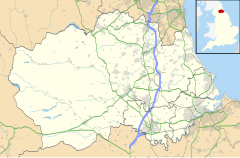Ulnaby
| Ulnaby | |
|---|---|
 Ulnaby Hall Farm, site of lost village |
|
| Ulnaby shown within County Durham | |
| Area | 0.16 km2 (0.062 sq mi) |
| Population | 0 |
| • Density | 0/km2 (0/sq mi) |
| OS grid reference | NZ226172 |
| Unitary authority | |
| Ceremonial county | |
| Region | |
| Country | England |
| Sovereign state | United Kingdom |
| Post town | DARLINGTON |
| Postcode district | DL2 |
| Dialling code | 01325 |
| Police | Durham |
| Fire | County Durham and Darlington |
| Ambulance | North East |
| EU Parliament | North East England |
| UK Parliament | |
Ulnaby is an abandoned village and scheduled ancient monument in the grounds of Ulnaby Hall Farm, near High Coniscliffe, County Durham, England. The toft village was occupied from the late-13th to the 16th century and temporary buildings were erected in the 19th century. Ulnaby Hall farm appears to have been built in the late-16th century, supplanting a high status medieval manorial enclosure associated with the original village. It is thought that the village shrank because of the change from labour-intensive arable farming to pasture, before being abandoned and the site was subsumed into the farm as pasture.
The site is 6.8 km north-west of Darlington, in the grounds of Ulnaby Hall Farm, between Ulnaby Lane and the B6279, near High Coniscliffe, County Durham. The earthworks cover an area of 0.16 km2 under pasture, with the actual village covering 6.6 hectares. There are ridge and furrow areas to the north and west. There is visible evidence of two east–west rows of tofts either side of an east–west hollow way, and on the north side of the hollow way is the village green. The site, which slopes gently to the south, is bounded by roads on the north and west sides, and a stream to the south. Beneath the pasture the archaeology is on boulder clay overlying magnesian limestone. Three fields make up the site: an 1841 document says that the western field was called Back Field, the eastern field was Garths and the southern field was New Acridge Carr. The fields immediately to the west of the site were called Kiln Field and Lime Kiln Field, and there is evidence of quarrying in Back Field. A garth in this context is an enclosed garden, yard or paddock, and would refer to the existing earthworks. Carr refers to marshland in the context of old pasture.
The name, "Ulnaby", is possibly derived from the Old Norse for Ulfhethin's farm, which could imply that there was a pre-medieval settlement locally. Although archaeologists have not found reason to date the village itself before medieval times, there is local evidence of worked flints, a Bronze Age awl, three late Neolithic or early Bronze Age bowl barrows and the Roman road Dere Street, all within 3 kilometres. Roman items have been found locally at High Carlbury, High Coniscliffe and Ulnaby farm itself.
...
Wikipedia

